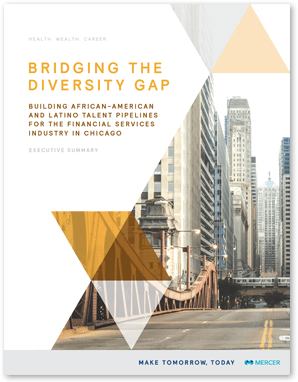Groundbreaking Research on African-Americans and Latinos in the Financial Sector Released at the FSP Initiative 2015 Summit
 On October 30, 2015, the Financial Services Pipeline (FSP) Initiative released a comprehensive report on diversity and inclusion in the Chicago region’s financial services sector. Researched and written by FSP’s partner, Mercer, “Bridging the Diversity Gap: Building African-American and Latino Talent Pipelines for the Financial Services Industry in Chicago” indicates that if current rates of hiring, promotion and attrition persist, the representation of African-Americans and Latinos in the sector’s leadership will decline over the next five years. An Executive Summary of the report is also available.
On October 30, 2015, the Financial Services Pipeline (FSP) Initiative released a comprehensive report on diversity and inclusion in the Chicago region’s financial services sector. Researched and written by FSP’s partner, Mercer, “Bridging the Diversity Gap: Building African-American and Latino Talent Pipelines for the Financial Services Industry in Chicago” indicates that if current rates of hiring, promotion and attrition persist, the representation of African-Americans and Latinos in the sector’s leadership will decline over the next five years. An Executive Summary of the report is also available.
Mercer’s research on behalf of FSP commenced in mid-2014 with a series of interviews with experts and leaders in human resources and diversity and inclusion from the different FSP member organizations. Research continued with the development of an aggregated Internal Labor Market (ILM) map, including data on hires, promotions and exits from members of the Initiative, as well as projections for expected representation of African-Americans and Latinos in the local financial industry within the next five years. Additionally, Mercer administered a survey to almost 10,000 leaders and professionals working at FSP member organizations in order to learn about the construction of their professional identities as members of the financial sector, their experiences in the industry, and their ideas on how to enhance diversity and inclusion in the sector. All these research components along with a series of focus groups, a literature review and a program scan will inform the development of a robust action plan by the FSP Steering Committee.
“Bridging the Diversity Gap” aggregates the findings and presents suggestions for future actions from the sector. Key findings from the research include:
- Employers are more challenged by retaining than hiring African-American and Latino talent.
Attrition rates in the industry run higher for African-Americans and Latinos relative to others. - Among professional-level employees in the industry, African-Americans and Latinos often report more favorable experiences relative to others.
African-Americans and Latinos also experience favorable rates of promotion from professional-level to managerial-level positions, although their exit rates from this level are higher than the exit rates for whites. - Early exposure to the industry is associated with a favorable view of the industry among African-Americans and Latinos.
African-Americans’ and Latinos’ interest in working in financial services often crystallizes during the high school years, compared to college years for whites. - Once employed, African-Americans and Latinos report distinctive experiences in, and perceptions of, the industry.
Fairness, and leadership commitment to diversity and inclusion, for example, are perceived less often by African-Americans and Latinos. - African-Americans and Latinos are most strongly influenced to stay in the industry by opportunities to achieve their long-term career goals.
By comparison, whites’ intent to stay in the industry is more strongly influenced by relationships and by considerations of prestige and status.
The report presents recommendations for individual employers and for the industry as a whole to address diversity and inclusion gaps in the sector. The report recommends that individual employers work to fill senior leadership from within, reduce attrition, and hire African-American and Latino talent at the Professionals career level. The report also encourages demonstration of commitment to diversity and inclusion by top leadership as well as actions to ensure fairness. Collectively, the industry needs to build community relations to create early awareness of opportunities in the financial services sector, giving African-Americans and Latinos early positive exposure to the sector. It would also behoove the sector to identify diverse talent with skills transferable to the sector, allowing recruiters to target talent from other industries, and to expand industry recruitment efforts of new graduates, widening the number and types of university sources of talent. Together, these actions would enlarge the pool of talent for recruitment into the industry.
